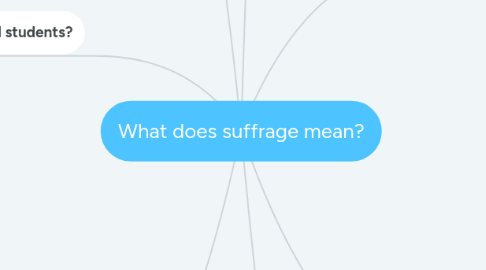
1. To people of color?
1.1. Church was the first place black women could speak out
1.2. Black women not included in the question "Which women?"
1.2.1. Only for white, middle class women
1.3. The 15th amendment gives black men the right to vote
1.3.1. Language implies all people, but it just means men
1.3.1.1. Furthers the divide between the women's movement and the abolition movement
1.4. Some argued that black men's rights should come before women's rights
1.4.1. Caused some organizations to separate from abolition movements
1.5. Abolition movements connected with women's rights movements
1.5.1. "Right is of No Sex" Fredrick Douglass
2. To high school students?
2.1. Shortridge High School Senate Debates
2.1.1. Taught by many women involved in the suffrage movement, including Charity Dye
2.1.2. Debates for suffrage
2.1.2.1. Women are just as capable as men
2.1.2.2. Women's interests are not covered by men
2.1.2.3. Women would abolish the "great evil" of drinking
2.1.2.4. Women would take better care of the home if given the vote
2.1.2.5. It is unlawful to not give women a vote
2.1.2.6. Other places that gave women suffrage were successful
2.1.3. Debates against suffrage
2.1.3.1. Women are sentimental, and will vote based on sentiment rather than facts
2.1.3.2. Women are not as politically competent as men
2.1.3.3. Women have yet to prove their worth
2.1.3.4. Men's interests would be ignored
3. In Indiana
3.1. Rural Indiana during the progressive era
3.1.1. Men felt they were in control. Toxic masculinity
3.1.2. Women pushed into the private sphere of the home to care for house and kids
3.1.3. Men worked and controlled politics
3.1.4. Populism offered women rights
3.1.5. Hannah Hiatt's convention in Richmond, IN
3.1.6. Suffrage conventions become very popular
3.1.7. The Whig Party allowed women access to politics
3.2. Political Activism
3.2.1. 1844:Petition for married women to own property
3.2.2. Mary F. Thomas: First Hoosier woman to speak in front of General Assembly
3.2.3. Women's Franchise League
3.3. Ida Husted Harper, May Wright Sewall, Amanda Way, and many more
4. Seneca falls as an origin story?
4.1. 1848 meeting counted as the beginning of the women's suffrage movement
4.1.1. Now thought of as before and after Seneca Falls
4.1.2. People in attendance who were involved in previous suffrage movements largely ignored
4.2. Goes back much further than 1848
4.2.1. Angered many women involved in women's suffrage movements prior to the meeting
4.3. Fabricated mainly by Susan B. Anthony
4.4. Respectability politics
4.4.1. Nice and neat story, excluding all the history of racism and struggle
5. To Women?
5.1. "Remember the Ladies"
5.2. Catherine Beecher: overlook people's rights in order to keep the nation together
5.3. Temperance
5.3.1. Women wanted prohibition because their husbands would spend all the money on alcohol and some abuse them
5.4. Which women?
5.4.1. Predominantly a movement for upper-class, white women
5.5. Child labor laws
5.5.1. Age of consent being raised
5.6. Being taxed without having any representation
5.7. Sex politics
5.7.1. Victoria Woodhull and her radical free love movement
5.7.1.1. Those against women's suffrage used Woodhull to discredit the entire movement
5.7.1.2. Suffragettes were reluctant to include her in the movements
5.7.1.3. Immoral women
5.7.1.3.1. But really, what good woman made radical change?
5.7.1.4. Suffragettes were reluctant to include her in the movements
5.8. Ownership rights
5.8.1. Could not own their own land
5.8.2. Had no say in money they made
5.8.2.1. Men could spend it on alcohol and not bills, which led to the temperance movements
6. To Men?
6.1. Some men found it all to be humorous
6.2. William Knight and his theory of taxation because of suffrage
6.3. John Young: "'these very extravagancies, ladies, show that impulse and feeling prevail too much in your nature to fit you for the cool calculations of statesmanship" (Bowman, 10).
6.4. Threatened masculinity
6.4.1. Women were meant to be in the home and take care of the men and home
6.4.2. Also threatened family dynamics
6.4.2.1. Women less likely to care for the home if they were involved in political matters
6.5. Some men, especially those involved in abolition movements, were for women's suffrage
6.5.1. Frederick Douglass involved in the suffrage movement, and was present at Seneca Falls
7. To Religion?
7.1. A tool to oppress women
7.1.1. 1830's religious reforming
7.1.1.1. Fanny Wright infidelity
7.1.1.1.1. Used to incite the dangers of women's political activism
7.1.1.1.2. Discouraged freethinking
7.1.2. Respectability politics
7.1.2.1. How should a white, middle class woman behave in order to be respected?
7.1.3. Disallowed women to speak in front of promiscuous crouds
7.2. A tool to empower women
7.2.1. Church allowed women a space to develop their political thoughts
7.2.1.1. Temperance
7.2.2. All people are created equal

